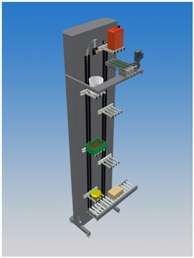Vertical conveyor
A vertical conveyor is a machine which can be used to move products automatically from one level to another.
In internal logistics, there are various ways for getting product flows up or down. A solution which is often used is the deployment of incline or lowering belts. When placed at an angle in order to bridge a height difference, such belt conveyors also have the advantage of covering a certain distance. A disadvantage is the loss of much useful floor space as a result of the presence of the necessary supports for the belt conveyor. A bigger distance over a smaller floor area can be bridged using a product lift or a vertical conveyor. A continuous conveyor or a discontinuous conveyor can be chosen as a vertical conveyor. Continuous conveyors can take the form of a spiral conveyor, an L-shaped conveyor or platform lift or a product lift fitted with a fork.
Discontinuous and continuous conveyors
A discontinuous conveyor also called a reciprocating elevator, lifts the product on to a platform using a platform, roller conveyor or belt conveyor and then moves the platform with the product to another level. Because of the cycle time required for input and output as well as lifting/lowering movements, such a conveyor can only be used for smaller capacities. Continuous conveyors are more suitable for bigger capacities. There are two important solutions which can be used for this group. It is possible to choose a spiral conveyor or a continuous product lift. Both solutions are able to handle several products at a time.
Spiral conveyor
The advantage of a spiral conveyor is that it can be used with a minimum amountof control software since it is continuously running, unlike o-lifts or platform elevators that require controls to time the infeed of the products to coincide with the arrival of a platform. If a product has to be supported so that it is flat during transport, this will only be possible if the belt is wider than the product. The drive motor of a spiral conveyor does not always need to be controlled with a frequency regulator. Spiral conveyors can deliver three times the throughput of an o-lift or platform elevator due to the ability to run continous. 3500-5000 shipping cases or cartons per hour are normal speeds for a spiral conveyor, while lifts handle these products with a throughput of only 1200-1500 CPH. Besides this the spiral conveyor is also a lot safer in operation and does not require safety fencing while o-lifts and platform elevators need to provide fencing in order to be safety compliant. Due to the moving platforms that could tear off a limb of not shielded by fencing. This makes platform lifts, if you include the fencing footprint, much larger in footprint than a spiral conveyor.
L-shaped conveyor or platform lift

Fork lift
A Fork lift can be arranged in more ways than an L-shaped conveyor or a platform lift and a spiral conveyor. A fork-lift is a product lift which lifts products from a conveyor using a fork and then places them at a different level on another conveyor. Such a fork-lift makes it possible to introduce or remove products at an angle of 90 degrees. As a result, the number of possible input and output combinations is somewhat larger. Because of the possibility of sliding conveyors in or out of the lift, a fork-lift can also be used as a vertical sorting system. With such a sorting installation, a product can be entered and removed at any level and a product can be lifted and lowered using one lift. The power and thus the energy consumption of the drive is considerably lower with a fork-lift than with other systems, since only the product weight needs to be transported and the forks maintain a balance between each other in the rising and lowering section. Another difference between a fork-lift and an L-shaped conveyor or platform lift is the complexity of the control. With an L-shaped conveyor or platform lift, input and output must be completely synchronous, whereas this is not necessary with a fork-lift. This ensures considerably simpler controls.
Other Names
- product lift
- case elevator
- incline belt conveyor
- elevator
- lift
- box lift
- spiral conveyor
- L-shaped conveyor
- reciprocating elevator
- S-conveyor
- Z-conveyor
- material lift
- freight lift